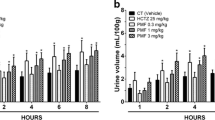Abstract
Since extracts from the plants Rhois aromatica and Solidaginis virgaurea are being used in the phytotherapy of bladder dysfunction including the overactive bladder syndrome, and since muscarinic receptors are the main pharmacological target in the treatment of bladder dysfunction, we have investigated whether these extracts can inhibit carbachol-induced, muscarinic receptor-mediated contraction of rat and human bladder. In vitro contraction experiments were performed with rat and human bladder strips. Radioligand binding and inositol phosphate accumulation studies were done with cells transfected with human M2 or M3 muscarinic receptors. Both extracts concentration-dependently (final concentrations 0.01–0.1%) inhibited carbachol-induced contraction of rat and human bladder with insurmountable antagonism. Radioligand binding experiments and inositol phosphate accumulation studies with cloned receptors demonstrated direct but non-competitive effects on muscarinic receptors. Reductions of KCl-induced bladder contraction demonstrated that inhibition by the higher extract concentrations also involved receptor-independent effects. We conclude that extracts from Rhois aromatica and Solidaginis virgaurea inhibit muscarinic receptor-mediated contraction of rat and human bladder. While this could contribute to the beneficial effects of these extracts in patients with bladder dysfunction, such therapeutic effects remain to be demonstrated in controlled clinical studies.






Similar content being viewed by others
References
Abrams P, Cardozo L, Fall M, Griffiths D, Rosier P, Ulmsten U, van Kerrebroeck P, Victor A, Wein A (2002) The standardisation of terminology of lower urinary tract function: report from the standardisation sub-committee of the International Continence Society. Neurourol Urodyn 21:167–178
Andersson K-E (1993) Pharmacology of lower urinary tract smooth muscles and penile erectile tissues. Pharmacol Rev 45:253–308
Chapple CR (2000) Muscarinic receptor antagonists in the treatment of overactive bladder. Urology 55 [Suppl 5A]:33–46
Fetscher C, Fleichman M, Schmidt M, Krege S, Michel MC (2002) M3 muscarinic receptors mediate contraction of human urinary bladder. Br J Pharmacol 136:641–643
Goepel M, Gronewald A, Krege S, Michel MC (1998) Muscarinic receptor subtypes in porcine detrusor: comparison with humans and regulation by bladder augmentation. Urol Res 26:149–154
Goepel M, Hoffmann J, Piro M, Rübben H, Michel MC (2002) Prevalence and physician awareness of symptoms of urinary bladder dysfunction. Eur Urol 41:234–239
Hegde SS, Eglen RM (1999) Muscarinic receptor subtypes modulating smooth muscle contractility in the urinary bladder. Life Sci 64:419–428
Herbison P, Hay-Smith J, Ellis G, Moore K (2003) Effectiveness of anticholinergic drugs compared with placebo in the treatment of overactive bladder: systematic review. BMJ 326:841–844
Kories C, Czyborra C, Fetscher C, Schneider T, Krege S, Michel MC (2003) Gender comparison of muscarinic receptor expression and function in rat and human urinary bladder: differential regulation of M2 and M3? Naunyn-Schmiedebergs Arch Pharmacol 367:524–531
Kubota Y, Nakahara T, Mitani A, Maruko T, Saito M, Sakamoto K, Ishii K (2003) Possible involvement of Ca2+-independent phospholipase A2 in protease-activated receptor-2-mediated contraction of rat urinary bladder. Naunyn-Schmiedebergs Arch Pharmacol 367:588–591
Leuschner J (1995) Anti-inflammatory, spasmolytic and diuretic effects of a commercially available Solidago gigantea herb extract. Arzneimittelforschung 45:165–168
Milsom I, Abrams P, Cardozo L, Roberts RG, Thüroff JW, Wein AJ (2001) How widespread are the symptoms of an overactive bladder and how are they managed? A population-based prevalence study. BJU Int 87:760–766
Nakahara T, Kubota Y, Mitani A, Maruko T, Sakamoto K, Ishii K (2003) Protease-activated receptor-2-mediated contraction in the rat urinary bladder: the role of urinary bladder mucosa. Naunyn-Schmiedebergs Arch Pharmacol 367:211–213
Schilcher H, Boesel R, Effenberger S, Segebrecht S (1989) Neuere Untersuchungsergebnisse mit aquaretisch, antibakteriell und prostatatrop wirksamen Arzneipflanzen. Urologe B 29:267–271
Schmidt M, Bienek C, van Koppen CJ, Michel MC, Jakobs KH (1995) Differential calcium signalling by m2 and m3 muscarinic acetylcholine receptors in a single cell type. Naunyn-Schmiedebergs Arch Pharmacol 352:469–476
Taguchi K, Yang M, Goepel M, Michel MC (1998) Comparison of human α1-adrenoceptor subtype coupling to protein kinase C activation and related signalling pathways. Naunyn-Schmiedebergs Arch Pharmacol 358:100–110
Wyndaele JJ (2001) The overactive bladder. BJU Int 88:135–140
Acknowledgments
This work was supported in part by grants from Organotherapeutische Werke GmbH (Ettlingen, Germany) and the Deutsche Forschungsgemeinschaft (Mi 294/7–1). VB was recipient of a thesis fellowship of the intramural grant program of the University of Essen Medical School (IFORES). We thank Annette Kötting for her skilful technical help with the inositol phosphate experiments.
Author information
Authors and Affiliations
Corresponding author
Rights and permissions
About this article
Cite this article
Borchert, V.E., Czyborra, P., Fetscher, C. et al. Extracts from Rhois aromatica and Solidaginis virgaurea inhibit rat and human bladder contraction. Naunyn-Schmiedeberg's Arch Pharmacol 369, 281–286 (2004). https://doi.org/10.1007/s00210-004-0869-x
Received:
Accepted:
Published:
Issue Date:
DOI: https://doi.org/10.1007/s00210-004-0869-x




